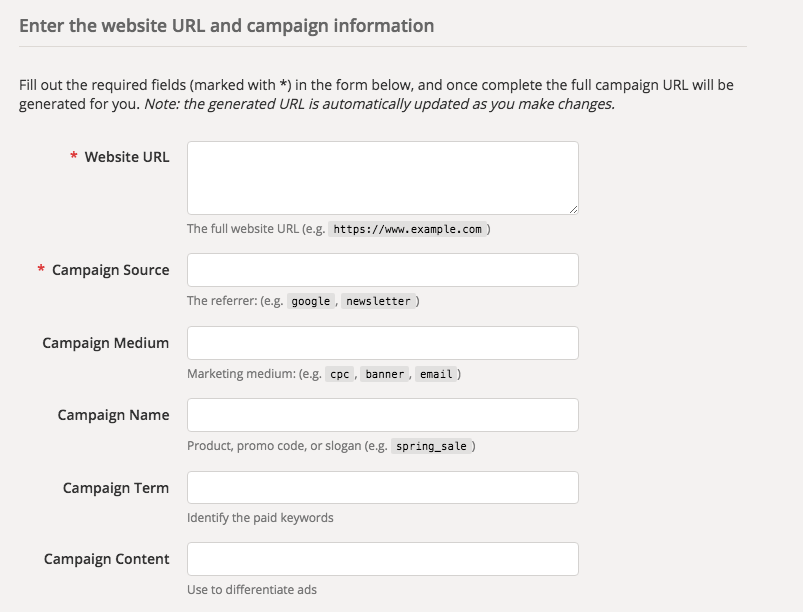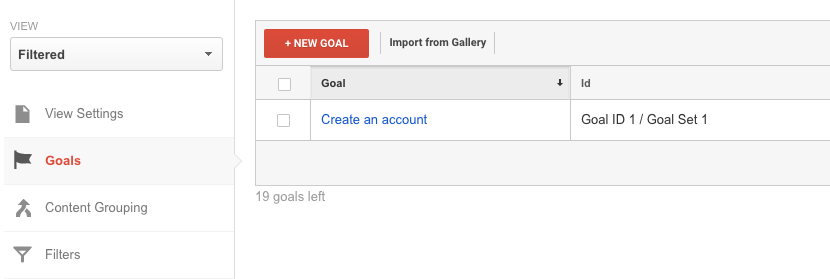There was a time when social shares and search engine rankings were gold. However, in the wake of ranking fluctuations due to personalization and geography and the loss of Twitter share counts — and potentially, Facebook share counts — marketers are struggling to find meaningful KPIs to report on.
Let’s look at more compelling metrics to consider, as well as tips on how to get them.
Engagement
It’s impressive to show that you have thousands of followers on social media and that’s growing every day, but what matters more is how engaged those followers are.
Your follower count is just a vanity metric if those followers aren’t actually clicking on your links and reading your content. Facebook likes, Twitter retweets and Instagram hearts don’t mean much without real engagement.
The best way to track this is to set up custom UTM links. Here’s how:
- Start by going to the Google Analytics Campaign URL Builder — you’ll find a form where you can enter the URL and other details about your campaign and generate a custom link
- The website URL is the link you want to drive traffic to — in this case, your blog post
- The other required field is the campaign source — this is just the social network you’re sharing the post on (Facebook, Twitter, Instagram or anything else)
- You can also enter a campaign name, such as the name of the post
Once you’ve created your custom links, you can start sharing it on your social networks and track the engagement. This can be found in Google Analytics under ‘Campaigns’ in your Acquisition reports.
The report allows you to neatly break down your engagement by source and track the number of visitors and their behavior on your site. Pay extra attention to these three metrics:
- Bounce rate
- Pages per session
- Average session duration
These are what define engagement. If you see a lot of traffic but high bounce rates and low session durations, that means people are clicking on your links but leaving immediately. If you’re only reporting on traffic and ignoring these other metrics, you’re only fooling yourself.
On the other hand, if you have low traffic but high engagement rates, you may be better off because you’ve got people who actually want to read your content and could be potential customers.
Email Subscribers
Along with engagement rates, a good sign that people want to read your content and learn more about your brand is when they sign up for your emails. They may not be in a position to buy just yet, but they’re keeping the option open by subscribing.
To start collecting email addresses, use tools like:
- OptinMonster: With OptinMonster, you can see conversion rates from visitor to subscriber for each post. This enables you to optimize your opt-ins as well as find posts that are the biggest drivers of subscribers.
- SumoMe: SumoMe is a WordPress plugin that lets you test the different options for asking your website visitors for their email addresses.
To get reports on your list growth, head to your email service provider. Software like HubSpot, MailChimp, and ConvertKit have detailed reports on your list growth.
Two more metrics to pay attention to here include:
- Email open rates
- Click-thru rates
Again, if people are subscribing to your emails but not engaging with them, your list size just becomes a vanity metric. Your email service provider will have detailed reports for each campaign and email you send out. Keep an eye on these numbers and look for ways to increase them.
Keep in mind: Your email subject lines are the biggest contributors to high open rates. Test them on your social networks first before using them in your emails. And always provide valuable content to subscribers, so they always look forward to the next email.
Leads and Sales
Your business survives on money. If you’re investing in creating content, you need to see returns. That means being able to track your qualified leads or sales directly back to content.
Do this by creating goals in Google Analytics. As a B2B, your goal might be form completions. As a SaaS, you might want to track software signups. And if you’re an e-commerce company, you can set specific e-commerce goals and even track revenue.
To create a goal for a form submission or software signup, head to the ‘Goals’ section under your Admin tab in Google Analytics.
There are three steps to creating a goal:
- Start by selecting a template from the available options. You can create a custom one, but chances are you already fall under one of the pre-set templates.
- The next step is defining the type of goal this is. For leads and sales, a destination goal works. Your leads and customers will likely see a thank you page after submitting a form or signing up.
- Enter that URL in the Goal Details section as your destination. Google will start counting conversions every time someone hits that page. Just make sure that people can’t reach the thank you page without going through a form or account creation process.
Now, you’ll be able to track conversions back in your reports. For example, if you’re looking at the Campaigns report, you’ll be able to see all the way through to conversions for each post.
Report on the Right Metrics
To uncover real growth, marketers need to stop reporting on vanity metrics and focus on the real issues. Social shares don’t matter if they don’t lead to traffic. Traffic doesn’t matter if it’s not engaged and subscribing. And subscribers don’t matter if they don’t actually open emails.
Dig deeper on your reports to find the metrics that actually lead to growth, and focus on those.
Image credits:
Screenshots taken by author on Oct. 1, 2016
Feature image: Shutterstock
Go to Source
Author: Joe Griffin Jr.
The post What to Do When Rankings and Social Share Reports Don’t Work by @joegriffin appeared first on On Page SEO Checker.
source http://www.onpageseochecker.com/what-to-do-when-rankings-and-social-share-reports-dont-work-by-joegriffin/


No comments:
Post a Comment